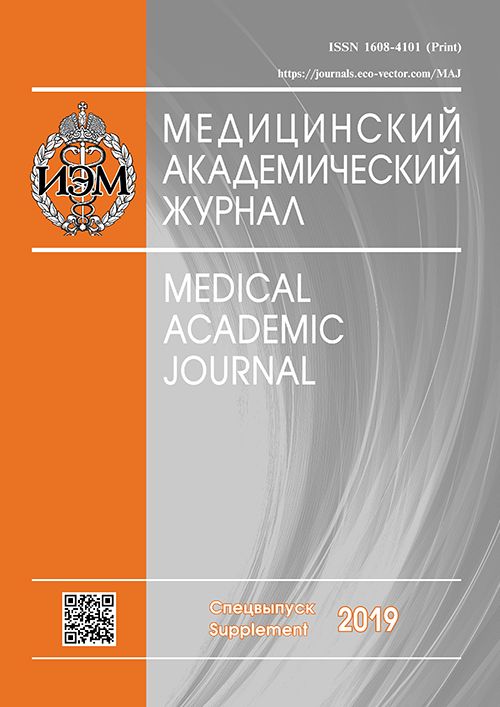STRUCTURAL AND FUNCTIONAL CHARACTERISTICS OF MICROGLIA IN THE POSTNATAL RAT STRIATUM
- Authors: Antipova MV1,2, Guselnikova VV2, Korzhevskii DE2
-
Affiliations:
- Saint Petersburg State University, Saint Petersburg
- Institute of Experimental Medicine, Saint Petersburg
- Issue: Vol 19, No 1S (2019)
- Pages: 133-134
- Section: Articles
- Published: 15.12.2019
- URL: https://journals.eco-vector.com/MAJ/article/view/19363
- ID: 19363
Cite item
Full Text
Abstract
The aim of this study was to evaluate the morphological and functional characteristics of microglial cells in the rat striatum at different stages of postnatal development. Using immunocytochemical methods and fluorescent microscopy, brain sections were analysed at each of the following postnatal ages: day 7 (n = 4), day 14 (n = 3), 4 to 6 months (n = 3). Different morphological and functional types of microglial cells were identified and characterized in details. It was noted that microglia activated during normal brain development do not contain vimentin, which is characteristic of stroke-activated microglia.
Full Text
Introduction. Microglia, the resident immune cells of the central nervous system (CNS), play an important role in CNS homeostasis during normal development, adulthood and ageing. Also, microglial cells are involved in the regulation of the immune response to pathological processes in the brain. It is wildly accepted that the microglia functional status is often correlated directly to their morphology [1]. Studying of morphological characteristics of microglial cells in normal and pathological conditions may contribute to the understanding of mechanisms of neuropathy, age-related brain changes, and progression of neurodegenerative diseases. The aim of this study was to evaluate the morphological and functional characteristics of microglial cells in the rat striatum at different stages of postnatal development. Materials and methods. Wistar rat brain sections were analyzed at each of the following postnatal ages: day 7 (n = 4), day 14 (n = 3), 4 to 6 months (n = 3). Rabbit polyclonal antibodies to Iba-1 (Abcam, UK) were used for identification of microglial cells. For simultaneous detection of microglia and intermediate filament protein vimentin, a double immunofluorescent reaction was performed using goat polyclonal antibodies to Iba-1 (Biocare medical, USA) and mouse monoclonal (clone V-9) antibodies to vimentin (Agilent, USA). Results and discussion. On the 7th day of postnatal development, different morphological types of microglia were detected in the rat striatum. Amoeboid microglia, characterized by round or oval body shape and the presence of a few thickened non-branching processes (figure, a), were prevail on this stage. Also, branched microglia were present in the striatum. Compared with amoeboid microglia, these cells were characterized by a smaller volume of perinuclear cytoplasm and the formation of thinner and longer low-branching processes. Polygonal cells (figure, b), spindle-shaped cells (figure, c) and unipolar cells (with one low-branching process) were identified among branched microglia. In the vicinity of the blood vessels, perivascular microglial cells with few thick low-branching processes were detected. A number of studies indicate that microglia activated during pathological process accumulate the vimentin in the cytoplasm [2]. Based on these data, we assumed that the presence of vimentin should also be characteristic of activated microglia in the developing brain. However, when analyzing the slides after double immunofluorescent reaction Iba-1/vimentin, we did not detect colocalization of fluorescent signals in any of the studied samples. This suggests that microglia in normal brain development and microglia in pathological conditions may have a different mechanism of activation (at least in vimentin expression). On the 14th day of postnatal development, microglial cells with intermediate morphology between amoeboid microglia and ramified microglia were identified in the striatum. Compared with amoeboid microglia, these cells were characterized by thinner and longer processes. But in contrast with ramified microglia, the processes of the cells were medium-branching (figure, d). Perivascular microglial cells were detected in the vicinity of the blood vessels. Iba-1 - immunopositive cells containing vimentin were not identified at this stage. In the striatum of adult rat brain, resting ramified microglial cells were found. This microglia is characterized by small cell bodies and numerous thin, long, and highly-branching in different directions processes (figure, e). Perivascular microglial cells, similar morphologically to perivascular microglia detected on the 7th and 14th days of postnatal development, were identified near the blood vessels (figure, e, arrow). Ramified microglia found in the adult CNS are vimentin-immunonegative.×
About the authors
M V Antipova
Saint Petersburg State University, Saint Petersburg; Institute of Experimental Medicine, Saint Petersburg
V V Guselnikova
Institute of Experimental Medicine, Saint Petersburg
D E Korzhevskii
Institute of Experimental Medicine, Saint Petersburg
References
- Wolf SA, Boddeke HW, Kettenmann H. Microglia in Physiology and Disease. Annual Review of Physio¬logy. 2017;79(1):619-643.
- Wilhelmsson U, Andersson D, de Pablo Y, et al. Injury leads to the appearance of cells with characteristics of both microglia and astrocytes in mouse and human brain. Cereb Cortex. 2017;6:3360-3377.
Supplementary files







